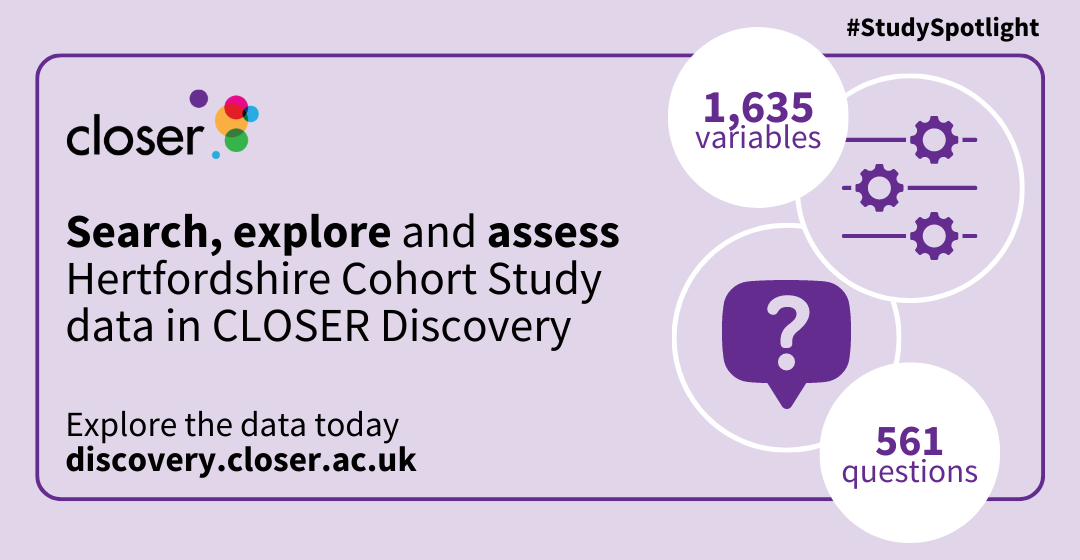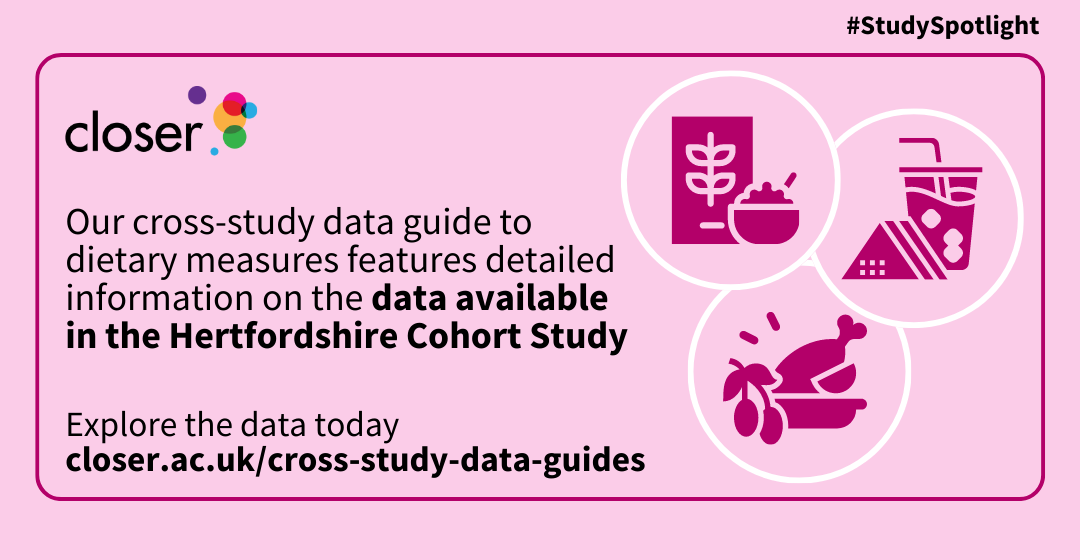 In the fourth blog of our Study Spotlight series, we continue to look at the studies in our partnership focused on the UK’s ageing population by shining the spotlight on our partnership’s oldest cohort – the Hertfordshire Cohort Study.
In the fourth blog of our Study Spotlight series, we continue to look at the studies in our partnership focused on the UK’s ageing population by shining the spotlight on our partnership’s oldest cohort – the Hertfordshire Cohort Study.
About the study
The discovery of a large set of birth records for people born in Hertfordshire during the first half of the twentieth century provided an opportunity to establish a longitudinal cohort study to help identify life course influences on ageing.
The Hertfordshire Cohort Study (HCS) is a unique study of 3,000 men and women born during the period 1931–39 in the English county of Hertfordshire and still resident there in the late 1990s. Participants have been regularly followed by home visits and questionnaires since 1998 by researchers at the MRC Lifecourse Epidemiology Unit at the University of Southampton, directed by Professor Cyrus Cooper.
Over the years, HCS has become a key source of evidence for life course influences on health and disease in later life. Recent research using the study data has investigated the relationship between people’s self-perceived risk of fracturing a bone and their prior fracture history, and the links between nutritional risk and physical function in older adults.
Find out more from the study’s deputy director, Prof Elaine Dennison, in our introduction to HCS video.
Discover the data
 If you’re interested in using data from HCS to carry out your own research into ageing, you might be wondering where and how to find out exactly what data has already been collected. That’s where our innovative research tool, CLOSER Discovery, comes into play!
If you’re interested in using data from HCS to carry out your own research into ageing, you might be wondering where and how to find out exactly what data has already been collected. That’s where our innovative research tool, CLOSER Discovery, comes into play!
CLOSER Discovery enables you to search, explore and assess HCS study data in an unprecedented level of detail. When you filter your search to look solely at HCS metadata, you’ll find a wealth of contextual information about 1,635 variables and 561 questions from the study. This metadata covers a diverse range of research topics including physical and mental health, health care and behaviour, family and social networks, and more!
Response to the COVID-19 pandemic
Back during the early stages of the COVID-19 pandemic, HCS launched a special sub-study to track how the pandemic and associated government measures were impacting older people’s lives. The sub-study also aimed to explore implications on participants’ physical and mental health. We plan to add the metadata from this survey to CLOSER Discovery in a future content update – watch this space!
In the meantime, however, it’s great to start seeing this data being used in new COVID-19 research. Researchers have used the data from HCS alongside the Health and Employment After Fifty (HEAF) Study to investigate the impact of the pandemic on factors relevant to musculoskeletal health, such as physical activity and nutrition, across the two studies. One of the main findings of the study was that 47% of HCS participants and 44% of HEAF participants reported being less physically active compared to before the pandemic, which could have a negative impact on musculoskeletal health.
Interested in finding out more? You can use our COVID-19 Research Tracker to access all the briefing notes, reports, academic publications and articles that cite HCS COVID-19 data.
Opportunities for cross-study comparisons
The research on COVID-19 and musculoskeletal health is a prime example of how HCS can be used in cross-study investigations with other longitudinal population studies. Cross-study analysis helps us understand more about group differences, the role of contextual factors and even how societal changes may impact on outcomes for individuals.
 To help researchers carry out their own cross-study comparisons, we’ve created a series of easily searchable cross-study data guides focused on three different areas of research. With our guide to dietary measures and estimated nutrient intake information, you can examine detailed information about the relevant data collected in HCS alongside seven other longitudinal population studies.
To help researchers carry out their own cross-study comparisons, we’ve created a series of easily searchable cross-study data guides focused on three different areas of research. With our guide to dietary measures and estimated nutrient intake information, you can examine detailed information about the relevant data collected in HCS alongside seven other longitudinal population studies.
Scratching the surface
This spotlight is only a whistle-stop tour of HCS and how you can use the study in your own research into the ageing population. As the study continues, we look forward to seeing what’s next on its horizon and continuing our work with the oldest cohort in our partnership.
You can keep up to date with all the latest developments on HCS and the longitudinal research community, sent direct to your inbox, via our monthly newsletter, Longitudinal News.
Further information
This blog is part of our ‘Study Spotlight’ series. This series showcases the CLOSER partner studies, demonstrating how to make the most of these valuable assets through CLOSER’s research resources. Every month, we turn the spotlight on a new theme, producing a series of blogs that delve into the backgrounds of studies that share similar characteristics, such as their study sample, design, or topics of research interest.
‘Study Spotlight’ helps you gain a deeper understanding of the studies in our partnership and how you can better utilise these on your research journey.
Keep an eye out for the next instalment when we shine the spotlight on the MRC 1946 National Survey of Health and Development
Previous Study Spotlight blogs:
- ALSPAC and the millennial generation (April 2023)
- Next Steps and the millennial generation (April 2023)
- ELSA and the ageing population (May 2023)
On Twitter? Follow #StudySpotlight to keep up to date with the series throughout the year.
Related links:
- Follow @MRC_LEU on Twitter
- CLOSER’s HCS study profile
- HCS study website
- Image sourced from the Centre for Ageing Better
Suggested citation:
Blows, J. (2023). ‘Study Spotlight: Hertfordshire Cohort Study and the ageing population’. CLOSER. 17 May 2023. Available at: https://closer.ac.uk/news-opinion/blog/study-spotlight-hcs/
